Sound City Blu-ray Movie
HomeSound City Blu-ray Movie 
RCA | 2013 | 108 min | Not rated | Mar 12, 2013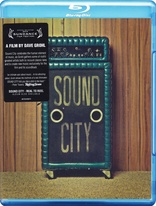
Movie rating
7.8 | / 10 |
Blu-ray rating
| Users | 0.0 | |
| Reviewer | 4.0 | |
| Overall | 4.0 |
Overview
Sound City (2013)
Foo Fighters frontman and former Nirvana drummer Dave Grohl directs this documentary about Los Angeles' Sound City Studios which specialised in analog recording. Following the closure of the studio in 2011 due to the growing demand for digital recording, Grohl assembled a number of artists, including Josh Homme, Trent Reznor, Paul McCartney and Stevie Nicks, to give interviews and performances while contributing to the creation of a new album.
Starring: Dave Grohl, Paul McCartney, Krist Novoselic, Pat Smear, Tom PettyDirector: Dave Grohl
| Music | Uncertain |
| Documentary | Uncertain |
Specifications
Video
Video codec: MPEG-4 AVC
Video resolution: 1080p
Aspect ratio: 1.78:1
Original aspect ratio: 1.78:1
Audio
English: LPCM 5.1
English: Dolby Digital 5.1
English: LPCM 2.0
Subtitles
English, French, German, Italian, Japanese, Portuguese, Spanish, Dutch
Discs
50GB Blu-ray Disc
Single disc (1 BD)
Playback
Region free
Review
Rating summary
| Movie | 4.0 | |
| Video | 4.0 | |
| Audio | 4.5 | |
| Extras | 3.0 | |
| Overall | 4.0 |
Sound City Blu-ray Movie Review
Dave Grohl's documentary debut is told with analog warmth.
Reviewed by Casey Broadwater April 22, 2013Rock songs—they just don't make 'em like they used to. Now, it's all ProTools and auto-tune, digital amp modelers and software plug-ins. Recently, the "virtual band" Gorrilaz even released an album recorded almost entirely with an iPad. When you can sequence drum tracks on the toilet between bouts of Angry Birds, who needs an antiquated analog music studio, with its tangles of wires and spools of magnetic tape? Well, Dave Grohl, for one. The former Nirvana drummer and present Foo Fighters frontman is no luddite, but he has a soft spot for the way things were in 1991 when he and Krist Novoselic and Kurt Cobain recorded Nevermind—the album that made them famous—at the rinky-dink Sound City Studios in suburban Los Angeles. Out among an unremarkable stretch of warehouses in Van Nuys, the now-shuttered studio didn't look like the sort of place where rock gods were born—"I remember pulling into the parking lot," says Grohl, "and thinking, really?"—but it had at least three things going for it: 1.) Killer acoustics for recording drums, 2.) a legendary and nearly one-of-a-kind mixing console, and 3.) a row of gold and platinum records on the wall to prove that this was where magic was made.

The place obviously altered the trajectory of Grohl's life, so it's fitting that his directorial debut is—first and foremost—a loving documentary tribute to the studio and its 42-year existence, which is covered in detail during the film's first hour. Founded in 1969 in a former Vox amplifier factory, Sound City eventually became a cigarette butt and whisky bottle-strewn hovel, variously described by Grohl's interviewees as "dumpy," a "shit-hole," and "a time warp." But they all say this lovingly, and it's obvious that the filth contributed to some kind of rock 'n' roll voodoo inside. The grime was the patina of the musical history made there. It was at Sound City that Buckingham Nicks morphed into Fleetwood Mac, where Neil Young pulled up in a hot-boxed Cadillac to record After the Goldrush, where Tom Petty and REO Speedwagon and Cheap Trick cut some of their most influential albums. Members of most of these bands show up here to reminisce, along with famed producer Rick Rubin, Metallica's Lars Ulrich, Pixies' Frank Black—or Black Francis, or whatever he goes by now—and Queens of the Stone Age's Josh Homme, among others.
The studio's first huge hit was Rick Springfield's "Jessie's Girl," which gave Sound City an influx of cash and plenty of new artists clamoring to record there in the early 1980s. Within a few years, though, the advent of digital recording and producing techniques had left the studio in dire financial straits. There's a whole other documentary that could be made here about the rapid changes in the music industry, and Grohl shapes out an overview without losing sight of his real subject. The studio's renaissance came in the 1990s, when grunge bands and other alternative artists—Nirvana, Rancid, Weezer, Rage Against the Machine—backlashed against digital in favor of good old fashioned reel-to-reel tape machines and vintage mixing consoles. Room acoustics were only half of Sound City's distinct sound; the other half was the warm analog recording process, routed through a custom-built Neve 8026 mixer that cost $76,000—which could've bought two houses out in the valley—when it was installed in the early '70s. This multi-knobbed control board is "the center of the spaceship," and Grohl and his gear- head interviewees practically fawn over its capabilities. "That board is the reason I'm here right now," says Grohl. "I'd do anything for it."
And so he does. When Sound City closed its doors in 2011, Grohl bought the mixing console and installed it in his own home studio with the aim of recording an album collaboratively with various rock 'n' roll all-stars who are also indebted to it. The result is the soundtrack Real to Reel, and the last third of the film gives us a look into these recording sessions, which feature the so-called "Sound City Players," a veritable supergroup consisting of Stevie Nicks, Trent Reznor, Krist Novoselic, and over a dozen other music industry titans. Even Paul McCartney drops in to scream and shred on an amped up blues number called "Cut Me Some Slack." None of the new songs we hear carry any of the same weight as the hits produced in Sound City over the decades—how could they?—but Grohl & Co. seem to be having a blast, giddy like high schoolers in a garage when a riff comes together. And that, in general, is what Sound City captures best. Behind the showmanship and bluster of rock, there's a fun and intimate alchemy involved in the process of creating and recording music, of "getting it on tape." The means of production may be changing—from analog to ones and zeros—but the joy of seeing musicians doing what they do will always be the same.
Sound City Blu-ray Movie, Video Quality 
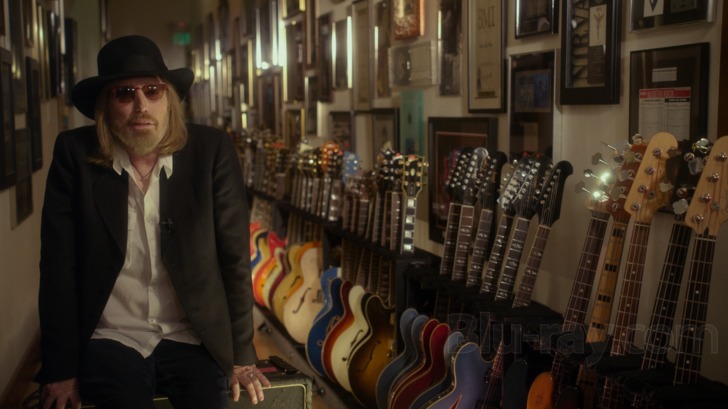
If you care to think about it, there's a sort of aesthetic dissonance in a film celebrating the joys of analog music production being shot digitally, but how many documentaries are made on 35mm these days? Regardless, Sound City generally looks great on Blu-ray, with a 1080p/AVC-encoded presentation that's true to its source material, whether it's the Red Epic footage of the talking-head interview segments, or the much rougher archival clips, pulled from ancient duped VHS tapes and other standard definition sources. The vintage stuff can't be improved much, but the interviews and recording sessions are sharp and clean, barring some light noise in the somewhat dark studio interiors. Fine facial and clothing detail is easily visible, and there's no evidence of over-sharpening, DNR, or harsh compression. There are a few moments when the color grading seems a little wonky—with too much yellow in the highlights—but otherwise the picture looks natural and dense, with balanced contrast. There are no real issues or distractions here.
Sound City Blu-ray Movie, Audio Quality 
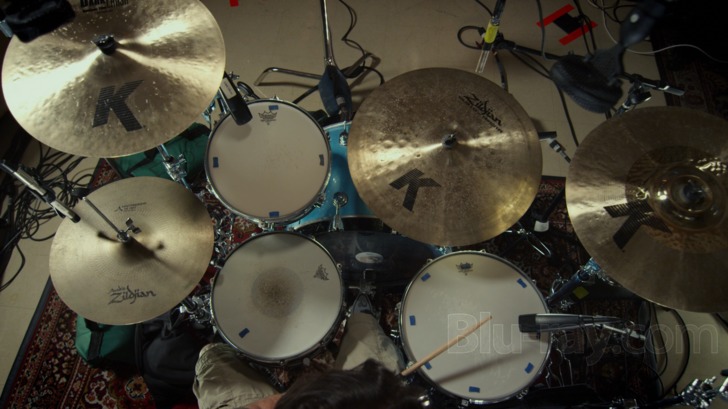
You'll find three audio options on the disc, an uncompressed Linear PCM 5.1 surround mix, a PCM 2.0 stereo fold-down, and a lossy Dolby Digital 5.1 track. For some reason, the stereo mix is the default—and it sounds fine for what it is—but if you've got a capable home theater set-up, you'll best be served by switching over to the multi-channel PCM track, which expands the audio with more pronounced bass and an effective use of the rear speakers for musical bleeding room. The audio for the interview segments is functionally straightforward—crisp, unmuffled, and always easy to understand—but the mix really shows its worth whenever there's music blaring. Crunchy guitars, tight snare hits, bright cymbal crashes, thumping kick drum—it's all rich and dynamic. The recording sessions at Grohl's 606 Studio sound fantastic too, pumped through the legendary Neve mixing console. The disc also includes plenty of subtitle options; see the top of the page for details.
Sound City Blu-ray Movie, Special Features and Extras 
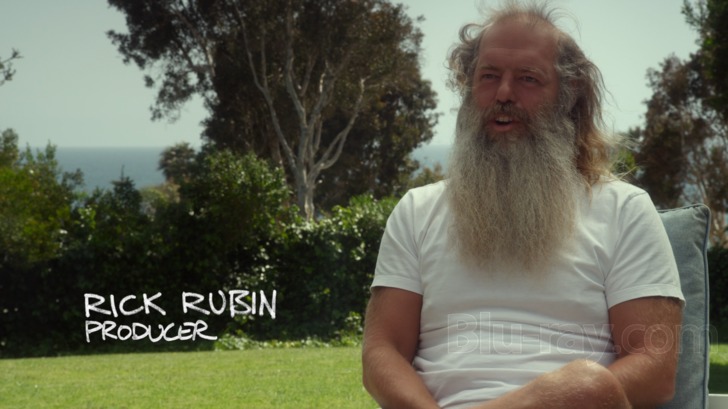
The only extras on the disc are three extended recording sessions, taking us inside Dave Grohl's 606 Studio, the new home of Sound City's famous Neve mixing console.
- "From Can to Can't" (HD, 19:48): Watch Slipknot vocalist Corey Taylor, Cheap Trick guitarist Rick Nielsen, and Kyuss bassist Scott Reeder track parts for "From Can to Can't."
- "Your Wife is Calling" (HD, 15:04): Likewise, see froggy-voiced former Fear frontman Lee Ving lay down his call- and-response vocals for "Your Wife is Calling.":
- "Time Slowing Down" (HD, 9:46): Rage Against the Machine bassist Tim Commerford and drummer Brad Wilk join Dave Grohl on guitar.
Sound City Blu-ray Movie, Overall Score and Recommendation 
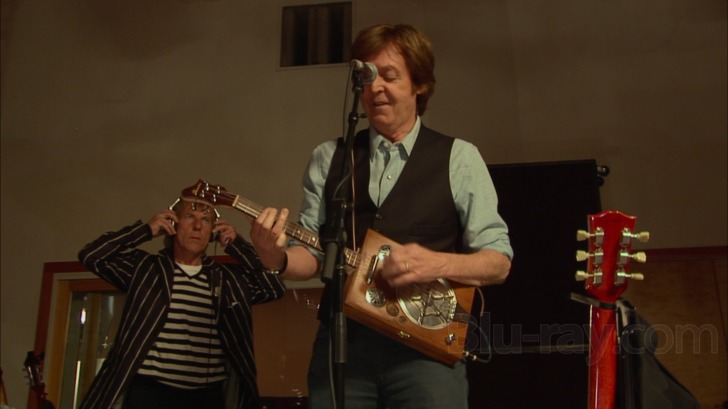
Sound City is a tribute to an unlikely place—a grimy studio in industrial Van Nuys—and the influential behind-the-music part it played in four decades of rock 'n' roll history, from Neil Young's After the Gold Rush to Death Cab for Cutie's Codes and Keys. Drummer-turned-frontman-turned-documentarian Dave Grohl gathers together fellow musicians, audio engineers, and producers to recount that history, and the result is a film that's part gear-head geek-out, part supergroup recording session, and part celebration of the days when all rock was recorded to magnetic tape in analog-only studios. If you're at all interested in what goes on before a hit song gets pumped out of the radio, it's definitely worth checking out. I only wish the film's Blu-ray release included a copy of the soundtrack. Regardless, the audio/video quality of the release is excellent, and the bonus material does give us some additional access to the "Sound City Players" tracking their parts. Highly recommended!
Similar titles
Similar titles you might also like

Foo Fighters: Back and Forth
2011

Foo Fighters: Sonic Highways
2014

Searching for Sugar Man
2012

The Wrecking Crew
2008

Oasis: Supersonic
2016

Linda Ronstadt: The Sound of My Voice
2019

All Things Must Pass: The Rise and Fall of Tower Records
2015

Whitney
2018

The Decline of Western Civilization
1981

Rush: Beyond the Lighted Stage
2010

Foo Fighters: Live at Wembley Stadium
2008

Muscle Shoals
2013

20 Feet from Stardom
2013

Score: A Film Music Documentary
2016

Pearl Jam Twenty
2011

Hype!
Collector's Edition
1996

It Might Get Loud
2008

George Harrison: Living in the Material World
2011

Big Star: Nothing Can Hurt Me
2012

The Song Remains the Same
Led Zeppelin
1976